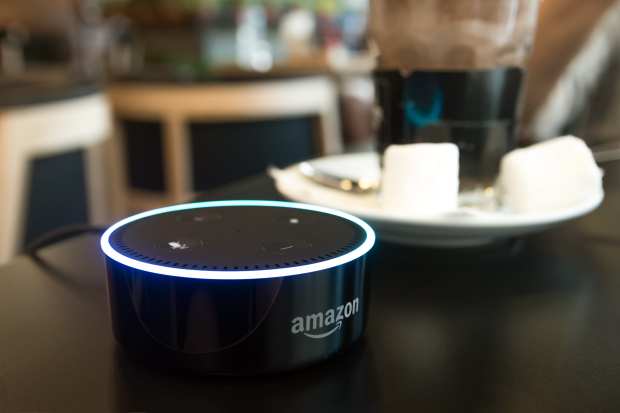Deep Dive: Voice Assistant Technology For Mobile Order-Ahead

Voice-activated food ordering was once limited to the realm of science fiction. Captain Jean-Luc Picard of “Star Trek: The Next Generation” was famous for ordering “tea, Earl Grey, hot” from the USS Enterprise’s replicator. Such tools are no longer at the far reaches of the universe, and today’s technologies would make the Enterprise’s crew feel right at home.
Millennials and members of Generation Z are particularly comfortable with voice-activated devices, with 25 percent of consumers aged 16 to 24 using smartphone-based voice assistants such as Siri or Cortana. Half of all searches are expected to be voice-activated by 2020. QSRs and other mobile ordering providers are recognizing these solutions’ growing popularity and are working overtime to bring hungry customers their orders with voice alone.
Voice Assistants Spread Their (Buffalo) Wings
Wingstop, a fast-casual buffalo wings chain with 1,031 locations worldwide, tends to be an early adopter for new technologies. Its online platform, which now accounts for more than 20 percent of its sales, was first unveiled in 2009, making Wingstop one of the first players in the field to offer digital ordering. The restaurant integrated voice-activated technology in 2017, but Vice President of Digital Technology Kevin Fish noted there were plenty of challenges to overcome.
The lack of visual feedback on such devices prevented customers from checking their orders before confirming them. It was also a struggle for Wingstop to balance simple conversational AI with the need for detailed order customization. Accents also presented a problem for the Texas-based chain, as voice recognition tools have historically had trouble interpreting certain dialects.
Wingstop integrated Amazon’s Alexa to take care of the voice recognition issues upfront, as Amazon had plenty of experience dealing with hard-to-decipher users. Customers link their Wingstop accounts to their Alexa apps, enabling them to order wings with a simple vocal prompt. The kitchens receive the orders the same way as any other order, meaning there is little to no extra training for staff.
Other QSR Voice Ordering Initiatives
Pizza delivery chain Domino’s also entered the voice-activated mobile ordering scene relatively early. Its AI-enabled chatbot, Dom, was combined with voice-activated technology in 2014, allowing customers to place orders the same way they would with a live operator. Former CEO Patrick Doyle believed voice technology was the way of the future, stating in an interview with TheStreet, “Over the next three to five years … I think you will see more and more people using natural voice to place orders, as opposed to thumbing things into their screens.”
Dom, which recently processed its 500,000th order, is also an effective sales driver, as it automatically suggests side dishes, such as breadsticks or buffalo wings, and helps customers locate applicable coupons when they order.
Dennis Maloney, Domino’s chief digital officer, noted that Dom was just the first part of a three-step plan for voice-activated ordering. The second phase, which began in 2016, was integration with Alexa and Google Home, enabling customers to order pizza without even touching their phones. The third phase is still under development, but will include a phone-based conversational voice interface that enables AI to answer phones and take orders rather than human operators. This system is currently being tested at 40 Domino’s locations.
Starbucks introduced My Starbucks Barista in 2017, putting the coffee giant on the path to voice-activated ordering. The system allows customers to speak to the app to place food and drink orders, and they can even modify their orders as if they were speaking to a human barista. The system is powered by an AI program that can also process text-based orders. The company also integrated voice ordering into Alexa, enabling customers to reorder items they previously purchased. The feature requires customers to already have accounts attached to the Starbucks mobile app, from which Alexa can pull their favorite orders.
Third-Party Voice Recognition Developers
Third-party firms are also investing in voice-activated food ordering. Software firm Bensen AI has developed a digital voice-enabled interface for Google Assistant and Alexa that allows consumers to place orders at partnered eateries. Bensen processes each request, learns customers’ favorite orders and charges the appropriate card registered with Amazon or Google.
Orderscape is also working on voice-activated ordering technologies. The company created a voice ordering software layer that is compatible with web browsers, mobile devices and smart speakers, such as Amazon Echo. Orderscape doesn’t immediately connect users to specific restaurants, instead directing customers based on the meals they request. The software then works with restaurant ordering platforms, including Monkey Media, Olo and Onosys, to place customers’ orders.
Security and Privacy Issues
Voice ordering is gaining popularity despite the many security concerns. Customers may be reluctant to say their credit card information out loud, while others may not trust ordering platforms due to recent data breaches.
This is especially true for ordering systems that are compatible with Alexa, which recently faced scrutiny over the fact that Amazon has thousands of employees dedicated to listening to users’ voice recordings. The company stated that the aim of the eavesdropping was to help the AI understand human voices, but privacy advocates and government regulators rang the alarm over the invasion of consumers’ privacy. The California State Assembly’s privacy committee advanced the Anti-Eavesdropping Act in May to combat such issues. The legislation would require smart speaker developers to ask for users’ consent to store recordings.
These issues are concerning, but with more consumers and QSRs adopting such tools, voice-activated food ordering will likely continue to grow.
